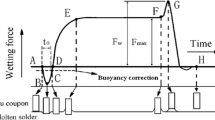Abstract
In order to understand the reliability relationship between solderability and oxygen content which on the surface of Au–20Sn solders, the wettability, microstructure and solderability of Au–20Sn solders with different oxygen content have been investigated in this study. Results showed that oxygen content significantly influence the wettability of Au–20Sn solders because of oxide films, and the worst wettability was achieved by containing 102 ppm oxygen with spreading area reducing to 52.3 mm2, which was about 45.8% smaller than that of the solder contained 16 ppm oxygen. In addition, the flux provided a good wetting behavior of Au–20Sn solders when the oxygen content was relatively high. The main oxide films on the surface of Au–20Sn solders were verified that composed of SnO and SnO2 by way of X-ray diffractometer determination, and the reason for the formation of surface oxides has been briefly analyzed and discussed. Meanwhile, the microstructure displayed varying degree deterioration with the increase of oxygen content, and the surface oxide started to be appeared in Au–20Sn solders when the oxygen content reached 42 ppm. On the other hand, the increase of oxygen content would induce pores and cracks of soldered joints, which may finally deteriorate the reliability, and the solderability of solders on Cu substrate indicated that the oxygen content is preferably less than 20 ppm when Au–20Sn solders are used for fluxless bonding.










Similar content being viewed by others
References
J. Peng, R.C. Wang, M. Wang, H.S. Liu, J. Electron. Mater. 46, 2021 (2017)
H.M. Chung, C.H. Chen, C.P. Lin, C.J. Chen, J. Alloys Compd. 485, 219 (2009)
J.Y. Tsai, C.W. Chang, C.E. Ho, Y.L. Lin, C.R. Kao, J. Electron. Mater. 35, 65 (2006)
J.W. Yoon, H.S. Chun, S.B. Jung, J. Mater. Res. 22, 1219 (2007)
Y.T. Lai, C.Y. Liu, J. Electron. Mater. 35, 28 (2006)
Z.X. Zhu, C.C. Li, L.L. Liao, C.K. Liu, C.R. Kao, J. Alloys Compd. 671, 340 (2016)
P.J. Wang, J.S. Kim, C.C. Lee, J. Electron. Mater. 38, 2106 (2009)
J. Jiang, J.E. Lee, K.S. Kim, K. Suganuma, J. Alloys Compd. 462, 244 (2008)
M. Yunus, K. Srihari, J.M. Pitarresi, P. Anthony, Microelectron. Reliab. 43, 2077 (2003)
J. Lee, K. Tanaka, M. Yamamoto, H. Shigeta, Mater. Trans. 45, 625 (2004)
J. Kim, H. Schoeller, J. Cho, P. Seungbae, J. Electron. Mater. 37, 483 (2008)
J.F. Kuhmann, A. Preuss, B. Adolphi, K. Maly, T. Wirth, W. Oesterle, W. Pittroff, G. Weyer, M. Fanciulli, IEEE Trans. Compon. Packag. Manuf. Technol. C 21, 134 (1998)
S.S. Zhang, Y.J. Zhang, H.W. Wang, J. Alloys Compd. 487, 682 (2009)
S.P. Yu, C.L. Liao, M.H. Hon, J. Mater. Sci. 35, 4217 (2000)
J.W. Yoon, H.S. Chun, J.M. Koo, S.B. Jung, Microsyst. Technol. 13, 1463 (2007)
J. Zhao, Q. Yuan, X. Kan, J.L. Yang, F.H. Yang, J. Micromech. Microeng. 27, 014003 (2016)
GB/T 11364-2008. China Standard Press (2008)
T. Farrell, Met. Sci. 10, 87 (1976)
Y.C. Chan, D.J. Xie, J.K.L. Lai, Mater. Sci. Eng. B 38, 53 (1996)
M.F. Arenas, M. He, V.L. Acoff, J. Electron. Mater. 35, 1530 (2006)
Acknowledgements
This project was supported by National Natural Science Foundation of China (Grant No. 51675269), the State Key Laboratory of Advanced Brazing Filler Metals & Technology (Zhengzhou Research Institute of Mechanical Engineering), China (Grant No. SKLABFMT201704) and the Priority Academic Program Development of Jiangsu Higher Education Institutions (PAPD).
Author information
Authors and Affiliations
Corresponding author
Rights and permissions
About this article
Cite this article
Wang, L., Xue, S. & Liu, H. Effect of oxygen content on wettability, microstructure and solderability of Au–20Sn solders. J Mater Sci: Mater Electron 29, 21130–21137 (2018). https://doi.org/10.1007/s10854-018-0261-0
Received:
Accepted:
Published:
Issue Date:
DOI: https://doi.org/10.1007/s10854-018-0261-0




